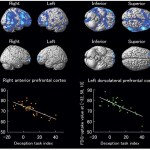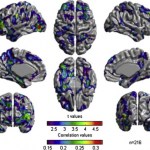brain
There is a fascinating case study in Current Biology.
de Gelder et al. discuss a patient -- referred to as TN to protect his privacy -- who had two sequential strokes that damaged his brain. The parts of the brain that were damaged included the primary visual cortex in both hemispheres -- rendering the patient blind. However, the patient could still respond to some visual stimuli through a phenomenon called blindsight.
Even more interesting, the patient could still navigate around visual objects, while reporting being unable to see them and having no memory for what they were.
I have…
I don't think I am alone in saying that I often feel a little envy and schadenfreude towards my peers. Science is a particularly competitive business with few remunerative rewards, so a lot of my self-worth is tied to comparisons with my peer's successes and failures. I won't deny being envious when someone gets a Science paper. And while seeing the abject failure of my peers isn't high on my list of priorities, I won't deny the small satisfaction that I get when someone who breezed through their PhD gets taken down a peg.
These aren't happy-joy-joy emotions. They don't make me swell with…
Neurological diseases can be strange in that they often have additional personality effects. If someone gets a cold, they sneeze a bunch but are basically the same person they were before the cold. In contrast, meningitis can include mental status and personality changes in its early stages -- including irritability and sleepiness. When a disease involves the brain, it can change who we are in addition to making us sick.
In this vein, I found this paper in the journal Brain particularly interesting. Abe et al. report that Parkinson's patients tell fewer lies than controls in a task where…
The journey undertaken by newly generated neurons in the adult brain is like the cellular equivalent of the arduous upstream migration of salmon returning to the rivers in which they were hatched. Soon after they are born in the subventricular zone near the back of the brain, these cells migrate to the front-most tip of of the olfactory bulb. This is the furthest point from their birth place, and they traverse two-thirds of the length of the brain to get there.
The first leg of this epic journey - the departure of the newborn cells from the subventricular zone - involves some of the…
Say the word 'statistician' and most people might think of an intelligent but reclusive person, probably working in a darkened room and almost certainly wearing glasses. But a new study shows that a monkey in front of a monitor can make a reasonably good statistician too.
Tianming Yang and Michael Shadlen from the University of Washington found that rhesus macaques can perform simple statistical calculations, and even watched their neurons doing it. Psychologists often train animals to learn simple tasks, where the right choice earns them a reward and the wrong one leaves them empty-…
It is now well established that the adult mammalian brain contains stem cells which continue to generate new neurons throughout life. This discovery, and subsequent research, has transformed the way we think about the brain. It is, for example, known that physical and mental exercise can stimulate the growth of new nerve cells in a part of the brain which shrinks in Alzheimer's and depression, and so it is believed that such activities can reduce the risk of both conditions.
Despite all this, little is known about the mechanisms by which neural stem cells are directed to generate neurons.…
For all appearances, this looks like the skull of any human child. But there are two very special things about it. The first is that its owner was clearly deformed; its asymmetrical skull is a sign of a medical condition called craniosynostosis that's associated with mental retardation. The second is that the skull is about half a million years old. It belonged to a child who lived in the Middle Pleistocene period.
The skull was uncovered in Atapuerca, Spain by Ana Gracia, who has named it Cranium 14. It's a small specimen but it contains enough evidence to suggest that the deformity was…
If someone told you that they wanted to have a perfectly good leg amputated, or that they have three arms, when they clearly do not, you would probably be inclined to think that they are mentally disturbed. Psychiatrists, too, considered such conditions to be psychological in origin. Voluntary amputation, for example, was regarded as a fetish, perhaps arising because an amputee's stump resembles a phallus, whereas imaginary extra limbs were likely to be dismissed as the products of delusions or hallucinations.
However, these bizarre conditions - named body integrity identity disorder (BIID)…
Numerous studies have attempted to correlate general intelligence with different anatomical measures. (You might even argue that the phrenologists were working in this vein.) Likewise many studies have attempted to relate intelligence to the function of different brain regions -- using techniques like fMRI or PET scanning. However, relatively few studies have attempted to correlate general intelligence with anatomical features of particular brains regions.
This is important because we know that the brain works not as regions operating in isolation, but as a set of neural systems…
We're used to thinking of neglect as a lack of appropriate care, but to a neuroscientist, it has a very different meaning. "Spatial neglect" is a neurological condition caused by damage to one half of the brain (usually the right), where patients find it difficult to pay attention to one half of their visual space (usually the left).
This bias can affect their mental images too. If neglect patients are asked to draw clocks, many only include the numbers from 12 to 6, while some shunt all the numbers to the right side. When two famous neglect patients were asked to describe a familiar square…
Be it in sports or comedy, they say that timing is everything. In evolution, it's no different. Many of the innovations that have separated us from other apes may have arisen not through creating new genetic material, but by subtly shifting how the existing lot is used.
Take our brains, for example. In the brains of humans, chimps and many other mammals, the genes that are switched on in the brain change dramatically in the first few years of life. But Mehmet Somel from the Max Planck Institute for Evolutionary Anthropology has found that a small but select squad of genes, involved in the…
How can a seemingly trivial head injury kill you?
To answer this, you need a little anatomy.
Your brain is a pretty important organ, and is well protected. It sits inside a thick armor (the skull) and floats cushioned in a bath of cerebral-spinal fluid. It's surrounded by several layers of tissue, and its blood supply is kept relatively separate from the rest of the body (the "blood-brain barrier"). This separation helps keep out toxins and micro-organisms (but is imperfect). Just beneath the skull is a tough, leathery layer called the dura mater. This picture shows the skull cut…
A couple of weeks ago, I wrote about propranolol, a drug that can erase the emotion of fearful memories. When volunteers take the drug before recalling a scary memory about a spider, it dulled the emotional sting of future recollections. It's not, however, a mind-wiping pill in the traditional science-fiction sense, and it can't erase memories as was so widely reported by the hysterical mainstream media.
The research that's published today is a different story. Jin-Hee Han from the University of Toronto has indeed found a way to erase a specific fearful memory, but despite the…
If you wanted to turn a rat into a fearless critter, unfazed by cats or bigger rats, the best way would be to neutralise a small pair of tiny structures in its brain called the dorsal premammillary nuclei, orPMD. According to new research by Simone Motta at the University of Sao Paolo, these small regions, nestled within a rat's hypothalamus, control its defensive instincts to both predators and other rats.
But not all neurons in the PMD are equal. It turns out that the structures are partitioned so that different bits respond to different threats. The front and side parts (the ventrolateral…
Carl explains this:
After death, brains that do not simply disappear sometimes get smaller. In this particular fish, Sibyrhynchus denisoni the brain must have gotten a lot smaller. Check out this image, in which the braincase is in red, and the brain is in yellow. (The scale bar is 5 millimeters.)
The subject is a paper in PNAS that's available to journalists but no one else so far, yet not still embargoed ... a policy I sort of like for selfish reasons but still can't figure out. This means this link to the paper won't work for a few more days. Paper is on a 3M-year-old fossilized brain,…
Alzheimer's disease is the most common form of dementia in the world, affecting more than 26 million people. Creutzfeld-Jacob disease (CJD), another affliction is far less common, but both conditions share many of the same qualities. They are fatal within a few years of diagnosis, they are incurable and they involved the crippling degeneration of the brain's neurons. Now, a group of Yale researchers have discovered that the two diseases are also linked by a pair of critical proteins.
Look into the brain of someone with Alzheimer's disease and you will see large, insoluble "plaques" sitting…
Why did the evolution of a large brain happen only once (among mammals, and in particular, primates?)
Larger brains have evolved a number of times. It seems that there has been a trend over several tens of millions of years of evolution of larger brains in various clades, such as carnivores and primates. There is probably a kind of arms race going on among various species in which a larger brain is an asset.
However, as you imply, a really large brain (like the extraordinarily large human brain) seems to be very rare. One of the reasons for this is that there are at least two major kinds…
The trauma of child abuse can last a lifetime, leading to a higher risk of anxiety, depression and suicide further down the line. This link seems obvious, but a group of Canadian scientists have found that it has a genetic basis.
By studying the brains of suicide victims, Patrick McGowan from the Douglas Mental Health University Institute, found that child abuse modifies a gene called NR3C1 that affects a person's ability to deal with stress. The changes it wrought were "epigenetic", meaning that the gene's DNA sequence wasn't altered but it's structure was modified to make it less active.…
The blood that flows into our heads is obviously important for it provides nutrients and oxygen to that most energetically demanding of organs - the brain. But for neuroscientists, blood flow in the brain has a special significance; many have used it to measure brain activity using a technique called functional magnetic resonance imaging, or fMRI.
This scanning technology has become a common feature of modern neuroscience studies, where it's used to follow firing neurons and to identify parts of the brain that are active during common mental tasks. Its use rests on the assumption that the…
You swallow the pill. As it works its way through your digestive system, it slowly releases its chemical payload, which travels through your bloodstream to your brain. A biochemical chain reaction begins. Old disused nerve cells spring into action and form new connections with each other. And amazingly, lost memories start to flood back.
The idea of a pill for memory loss sounds like pure science-fiction. But scientists from the Massachussetts Institute for Technology have taken a first important step to making it a reality, at least for mice.
Andre Fischer and colleagues managed to restore…

